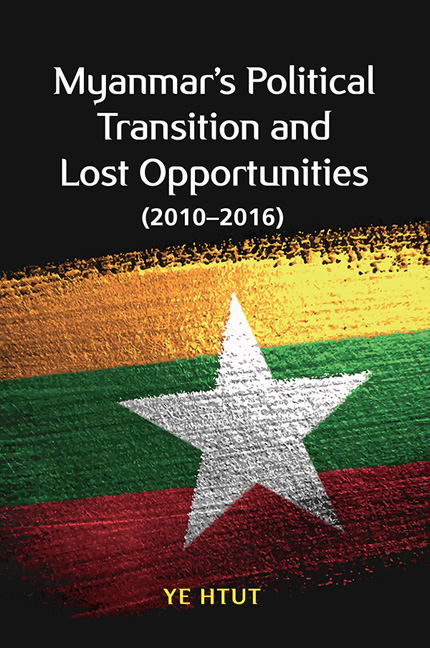Book contents
- Frontmatter
- Contents
- Foreword
- Acknowledgements
- Introduction: Myanmar's Political Reforms
- 1 The National Convention
- 2 The Constitution
- 3 The Union Solidarity and Development Party
- 4 Myanmar Spring and Aung San Suu Kyi
- 5 The Union Government
- 6 The Government and the Parliament
- 7 Shwe Mann's Checkmates
- 8 Turning Points
- 9 Media Reform
- Epilogue
- Appendix A President Thein Sein's Inaugural Address
- Appendix B President Thein Sein's First Address to the Cabinet
- List of Interviewees
- Index
- About the Author
- Plate section
4 - Myanmar Spring and Aung San Suu Kyi
Published online by Cambridge University Press: 25 January 2020
- Frontmatter
- Contents
- Foreword
- Acknowledgements
- Introduction: Myanmar's Political Reforms
- 1 The National Convention
- 2 The Constitution
- 3 The Union Solidarity and Development Party
- 4 Myanmar Spring and Aung San Suu Kyi
- 5 The Union Government
- 6 The Government and the Parliament
- 7 Shwe Mann's Checkmates
- 8 Turning Points
- 9 Media Reform
- Epilogue
- Appendix A President Thein Sein's Inaugural Address
- Appendix B President Thein Sein's First Address to the Cabinet
- List of Interviewees
- Index
- About the Author
- Plate section
Summary
President Thein Sein delivered his inaugural address at the Pyidaungsu
Hluttaw (Union assembly) on 30 March 2011. In his address the president
invited individuals and organizations that had criticized the seven-step road
map and the constitution to put aside their differences and work together
in the national interest. He also urged them to take power through elections
and amend the current constitution in accordance with the provisions in
it. Moreover, he promised to start a peace process with all ethnic armed
groups. He also outlined the following reform agenda:
To amend laws that were incompatible with the new constitution.
To submit bills to establish the fundamental rights of citizens.
To raise the salaries of government personnel and the pensions of retired former personnel.
To study and compile laws on the rights of farmers and review existing laws before amending them as necessary.
To review existing labour laws.
To submit a new Public Health Care and Social Security Law.
To introduce bills to promote health and education.
To revoke the existing press laws and introduce new bills to protect freedom of expression.
To promulgate laws on environmental conservation and amend laws on industry and mining.
To promulgate new environmental laws.
On 31 March the president delivered his first speech to his cabinet and outlined his priorities for the new government. These included:
Good governance and a clean government.
To promote democratic practices in government and society.
The rule of law.
Efficiency in government and public services.
The president stated that the first five years of the democratization process would be the most important, and if the government and people of Myanmar were able to implement concrete steps, the road to democracy would be smooth. Thein Sein thus set forth his vision of how to build Myanmar as a peaceful, modern and developed democratic state. The terms might be similar to those used by the previous military government, but the president carefully left out the words “disciplined democracy”. His intention was to avoid people seeing his democratic reforms as a form of guided democracy.
- Type
- Chapter
- Information
- Publisher: ISEAS–Yusof Ishak InstitutePrint publication year: 2019



